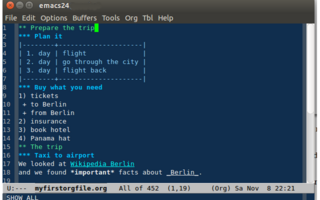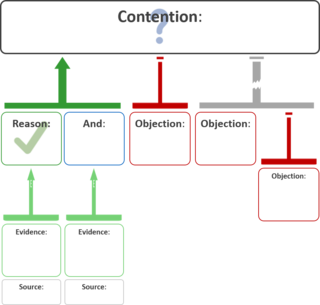Related Research Articles

A mind map is a diagram used to visually organize information into a hierarchy, showing relationships among pieces of the whole. It is often created around a single concept, drawn as an image in the center of a blank page, to which associated representations of ideas such as images, words and parts of words are added. Major ideas are connected directly to the central concept, and other ideas branch out from those major ideas.

An outliner is a specialized type of text editor used to create and edit outlines, which are text files which have a tree structure, for organization. Textual information is contained in discrete sections called "nodes", which are arranged according to their topic–subtopic (parent–child) relationships, like the members of a family tree. When loaded into an outliner, an outline may be collapsed or expanded to display as few or as many levels as desired.

Graph drawing is an area of mathematics and computer science combining methods from geometric graph theory and information visualization to derive two-dimensional depictions of graphs arising from applications such as social network analysis, cartography, linguistics, and bioinformatics.

Graphviz is a package of open-source tools initiated by AT&T Labs Research for drawing graphs specified in DOT language scripts having the file name extension "gv". It also provides libraries for software applications to use the tools. Graphviz is free software licensed under the Eclipse Public License.

FreeMind is a free mind mapping application written in Java, which is further developed by the fork Freeplane. FreeMind itself was last updated in 2014. FreeMind is licensed under the GNU General Public License Version 2. It provides extensive export capabilities. It runs on Microsoft Windows, Linux, and macOS via the Java Runtime Environment.

In information visualization and computing, treemapping is a method for displaying hierarchical data using nested figures, usually rectangles.

A tag cloud is a visual representation of text data which is often used to depict keyword metadata on websites, or to visualize free form text. Tags are usually single words, and the importance of each tag is shown with font size or color. When used as website navigation aids, the terms are hyperlinked to items associated with the tag.

An argument map or argument diagram is a visual representation of the structure of an argument. An argument map typically includes all the key components of the argument, traditionally called the conclusion and the premises, also called contention and reasons. Argument maps can also show co-premises, objections, counterarguments, rebuttals, and lemmas. There are different styles of argument map but they are often functionally equivalent and represent an argument's individual claims and the relationships between them.
WikiNodes is an app for the Apple iPad built by IDEA.org. WikiNodes was the first tablet app for browsing Wikipedia using a radial tree approach to visualize how articles and subsections of articles are interrelated. The app displays related items, which spread on the screen, as a spiderweb of icons.

Mindomo is a versatile freemium collaborative mind mapping, concept mapping and outlining tool developed by Expert Software Applications. It can be used to develop ideas and interactively brainstorm, with features including sharing, collaboration, task management, presentation and interactive web publication.
The Institute for Dynamic Educational Advancement (IDEA.org) is a U.S.-based nonprofit organization working in the area of scientific and cultural literacy. The organization was established in 1998 and incorporated in 2002, and has collaborated with museums, schools, nonprofit organizations, and public service projects.

A radial tree, or radial map, is a method of displaying a tree structure in a way that expands outwards, radially. It is one of many ways to visually display a tree, with examples extending back to the early 20th century. In use, it is a type of information graphic.
In network theory, link analysis is a data-analysis technique used to evaluate relationships between nodes. Relationships may be identified among various types of nodes (100k), including organizations, people and transactions. Link analysis has been used for investigation of criminal activity, computer security analysis, search engine optimization, market research, medical research, and art.

Google Fusion Tables was a web service provided by Google for data management. Fusion tables was used for gathering, visualising and sharing data tables. Data are stored in multiple tables that Internet users can view and download.
PhylomeDB is a public biological database for complete catalogs of gene phylogenies (phylomes). It allows users to interactively explore the evolutionary history of genes through the visualization of phylogenetic trees and multiple sequence alignments. Moreover, phylomeDB provides genome-wide orthology and paralogy predictions which are based on the analysis of the phylogenetic trees. The automated pipeline used to reconstruct trees aims at providing a high-quality phylogenetic analysis of different genomes, including Maximum Likelihood tree inference, alignment trimming and evolutionary model testing.
Discovr is a series of apps for the Apple iOS platform by David McKinney, which is characterized by using nodes to represent relationships between media in a tactile and visual way. There are apps for browsing music and movies.

NodeXL is a network analysis and visualization software package for Microsoft Excel 2007/2010/2013/2016. The package is similar to other network visualization tools such as Pajek, UCINet, and Gephi. It is widely applied in ring, mapping of vertex and edge, and customizable visual attributes and tags. NodeXL enables researchers to undertake social network analysis work metrics such as centrality, degree, and clustering, as well as monitor relational data and describe the overall relational network structure. When applied to Twitter data analysis, it showed the total network of all users participating in public discussion and its internal structure through data mining. It allows social Network analysis (SNA) to emphasize the relationships rather than the isolated individuals or organizations, allowing interested parties to investigate the two-way dialogue between organizations and the public. SNA also provides a flexible measurement system and parameter selection to confirm the influential nodes in the network, such as in-degree and out-degree centrality. The software contains network visualization, social network analysis features, access to social media network data importers, advanced network metrics, and automation.
Tanagra is a free suite of machine learning software for research and academic purposes developed by Ricco Rakotomalala at the Lumière University Lyon 2, France. · Tanagra supports several standard data mining tasks such as: Visualization, Descriptive statistics, Instance selection, feature selection, feature construction, regression, factor analysis, clustering, classification and association rule learning.
A software map represents static, dynamic, and evolutionary information of software systems and their software development processes by means of 2D or 3D map-oriented information visualization. It constitutes a fundamental concept and tool in software visualization, software analytics, and software diagnosis. Its primary applications include risk analysis for and monitoring of code quality, team activity, or software development progress and, generally, improving effectiveness of software engineering with respect to all related artifacts, processes, and stakeholders throughout the software engineering process and software maintenance.
Social navigation is a form of social computing introduced by Paul Dourish and Matthew Chalmers in 1994, who defined it as when "movement from one item to another is provoked as an artifact of the activity of another or a group of others". According to later research in 2002, "social navigation exploits the knowledge and experience of peer users of information resources" to guide users in the information space, and that it is becoming more difficult to navigate and search efficiently with all the digital information available from the World Wide Web and other sources. Studying others' navigational trails and understanding their behavior can help improve one's own search strategy by guiding them to make more informed decisions based on the actions of others.
References
- ↑ Peters, Tom (June 2009). "Spicy Poetry". Smart Libraries Newsletter. Vol. XXIX, no. 6, OCLC Reveals its Strategy for Library Automation. American Library Association. p. 7.
- ↑ Anderson, Carl; Byrne, Richard (2012). "Chapter 11: Online Mind Mapping". In McLeod, Scott; Lehmann, Chris (eds.). What School Leaders Need to Know About Digital Technologies and Social Media. John Wiley & Sons. ISBN 1118022246.
- ↑ Ng, Wan (November 2012). "Can we teach digital natives digital literacy?". Computers & Education. 59 (3): 1065–1078. doi:10.1016/j.compedu.2012.04.016.
- ↑ Holotescu, Carmen; Grosseck, Gabriela (2011). "M3-learning - Exploring mobile multimedia microblogging learning" (PDF). World Journal on Educational Technology. 3 (3): 168–176.
- ↑ Sheth, Nihar; Cai, Qin (29 April 2003). "Visualizing MeSH Dataset using Radial Tree Layout" (PDF). Indiana University, Bloomington.
- ↑ Börner, Katy (19 July 2010). "Science of Science Research and Tools Tutorial #07 of 12" (PDF).
- 1 2 Douma, Michael; Ligierko, Greg; Ancuta, Ovidiu; Gritsai, Pavel; Liu, Sean (2009). "SpicyNodes: Radial Layout Authoring for the General Public". IEEE Transactions on Visualization and Computer Graphics. 15 (6). doi:10.1109/TVCG.2009.183.
- ↑ Yee, Ka-Ping; Fisher, D.; Dhamija, R.; Hearst, M. (2001). Animated Exploration of Dynamic Graphs with Radial Layout. IEEE Symposium on Information Visualization. San Diego, CA. pp. 43–50. doi:10.1109/INFVIS.2001.963279.
- ↑ Douma, Michael; Ligierko, Greg; Romano, Joseph (13 April 2010). Concept Maps for On-line Exhibits: Using SpicyNodes. Archives & Museum Informatics: Museums and the Web 2010. Denver, CO.
- ↑ Douma, Michael; Ligierko, Greg; Romano, Joseph (4 August 2009). Creating Online Mind Maps and Concept Maps. 25th Annual Conference on Distance Teaching & Learning. Madison, WI – via Academia.edu.
- ↑ "Interactive Greek Gods Family Tree". webexhibits.org.
- ↑ "Week of August 22, 2010". 4kids.org. 22 August 2010.
- ↑ "Mythology". Mr. Rice. 7 January 2009.
- ↑ Felix, Michael (15 August 2007). Trellis: A Blog-Based Approach to the Development, Organization, and Visualization of Ideas (Thesis). hdl:10415/932.
- ↑ Neat Rox (27 October 2008). "WebExhibits Presents Daylight Savings Time Nodes". Neat Gemstones.
- ↑ "Websites". Cornerstones of Science. Archived from the original on 2011-08-14.
- ↑ "Daylight Saving Time - Why, When, Where?". Web Exhibits. Archived from the original on 12 March 2008.
- ↑ "Node View - Calendars". Web Exhibits. Archived from the original on 23 July 2010.
- ↑ "Node view: Poetry through the Ages". Web Exhibits. Archived from the original on 26 September 2008.
- ↑ Noor Haitham Saleem; Manjit Singh Sidhu; Naser Adnan; Nameer A. Shafeek; Maha.M.Ablahd Yousif (12 July 2011). Interactive Patterns of Interactions for a Mind Mapping Multimedia Courseware. 7th International Conference on IT in Asia (CITA). Sarawak, Malaysia. doi:10.1109/CITA.2011.5999504.
- ↑ Salmerón, Ladislao; García, Victoria (2012). "Children's Reading of Printed Text and Hypertext with Navigation Overviews: The Role of Comprehension, Sustained Attention, and Visuo-spatial Abilities". Journal of Educational Computing Research. 47 (1): 33–50. doi:10.2190/EC.47.1.b.
- ↑ "Spicynodes API". ProgrammableWeb. 14 December 2010. Archived from the original on 24 December 2010.
- ↑ "Best Websites for Teaching & Learning". American Library Association. Archived from the original on 2011-07-13.
- ↑ "The 35 Best Web 2.0 Classroom Tools Chosen By You". EduDemic. 8 July 2010. Archived from the original on 2010-08-27.
- ↑ "オススメの大学図書館ってありますか? - アクセス・蔵書数・快適さ・口コミなどを各大学調べてみた". calcweb.org (in Japanese).
- ↑ "k12webware - newtricks". wikispaces.com.[ permanent dead link ]
- ↑ "Herramientas colaborativas-Spicynodes". slideboom.com.[ permanent dead link ]
- ↑ "Tech Tip: www.spicynodes.com" (PDF). Archived from the original (PDF) on 2011-08-23. Retrieved 2011-05-14.
- ↑ "Spicy Nodes A Way To Visualize Online Information!". Geek Outpost. Archived from the original on 11 July 2011.
- ↑ "Spicynodes: Mindmapping plus". Instructional Design Fusions. 18 August 2010.
- ↑ "Spicynodes, a powerful mind-mapping tool". What Ed Said. 26 August 2010. Archived from the original on 2010-08-29. Retrieved 2010-08-27.
- ↑ Kane, Lauren (2 August 2010). "SpicyNodes- an online mindmapping tool". Diary of an Educational Developer. Archived from the original on 8 July 2011.
- ↑ "Unique Notions: Spicynodes for Mind Mapping / Course Mapping". itjil.blogspot.com. 12 June 2010.
- ↑ "Nodes and Birds". universeastext.com.[ permanent dead link ]
- ↑ "Edu Technophobia".[ permanent dead link ]
- ↑ "Genera nodos de pensamiento con SpicyNodes". Edumorfosis (in Spanish). 25 August 2010.
- ↑ Swanson, Kristen (28 October 2009). "Spicy Nodes: My NEW Favorite Presentation Tool". Teachers as Technology Trailblazers. Archived from the original on 2009-12-22. Retrieved 2010-08-29.
- ↑ "SPICYNODES: Free, Web Based Mind, Map Service". DE Tools Of The Trade. 12 October 2009. Archived from the original on 6 July 2011.
- ↑ Glynn, Mark (28 March 2012). "Embedding an interactive mindmap into your blog – SpicyNodes.org". Technology Enhanced Learning.
- ↑ Garza, Sally (12 August 2010). "Creative presentation tools". slideshare.net.
- ↑ "WikiNodes Brings A New Perspective To Knowledge » 148Apps » iPhone, iPad, and iPod touch App Reviews and News". 148Apps.[ permanent dead link ]
- ↑ Maintenay, Franck (25 August 2010). "SpicyNodes: dynamisez vos cartes Freemind/Freeplane". Freemind par l'exemple... (in French). Archived from the original on 3 September 2010.